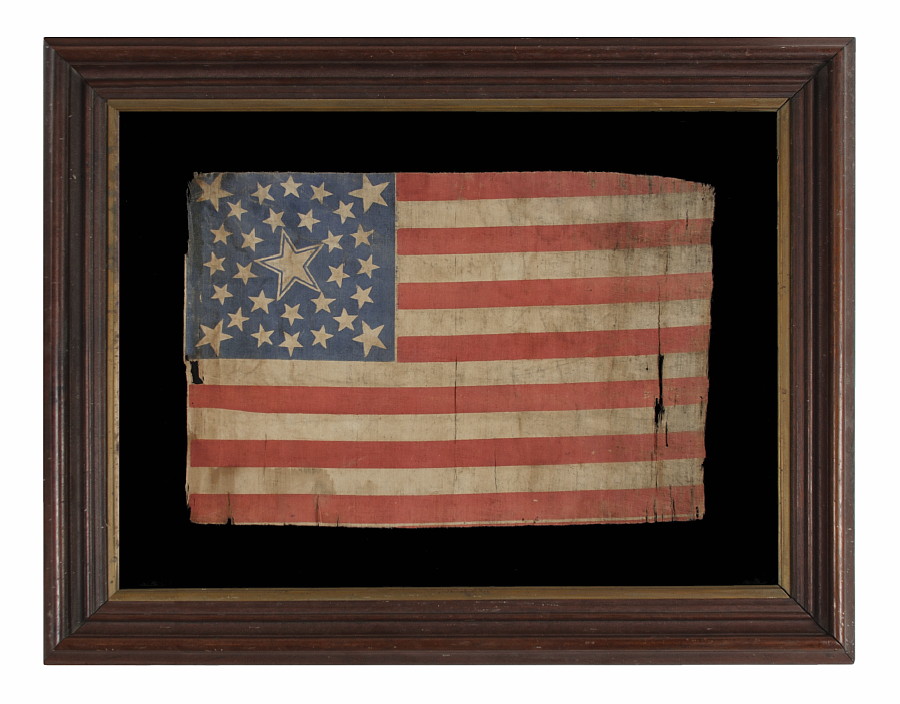
| |
30 STARS, PRE-CIVIL WAR, RARE AND BEAUTIFUL WITH A MEDALLION CONFIGURATION THAT FEATURES A HALOED CENTER STAR, WISCONSIN STATEHOOD, 1848-1850 |
|
| Available: |
Sold |
| Frame Size (H x L): |
Approx. 26.5" x 34" |
| Flag Size (H x L): |
14.5" x 21.75" |
|
| Description....: |
|
30 STARS, PRE-CIVIL WAR, RARE AND BEAUTIFUL WITH A MEDALLION CONFIGURATION THAT FEATURES A HALOED CENTER STAR, WISCONSIN STATEHOOD, 1848-1850:
30 star American national parade flag, printed on cotton, with a beautiful form of the medallion configuration that features a very large center star with a pinstriped halo around its perimeter and large flanking stars in each corner of the blue canton. Between these are two consecutive wreaths of stars in a third, considerably smaller size. Note attractive, persimmon red color of the stripes, which lends further appeal to this bold and whimsical design.
The 30th state, Wisconsin, joined the Union on May 29th, 1848. The 30 star flag was official until July 3rd, 1851, but 30 star flags would not likely have been made after the addition of California in 1850. This means that they had a realistic life span of about two years.
Flags made prior to the Civil War are generally rare, comprising less than one percent of 19th century flags that exist in the 21st century. This is partly because our flag was simply not used for most of the same purposes we employ it in today. Private individuals did not typically display the flag in their yards or on their porches. Parade flags did not often fly from carriages and horses. Places of business seldom hung flags in their windows. Use of the Stars and Stripes for these purposes rose swiftly following the Confederate attack on Fort Sumter that marked the outbreak of the Civil war, but civilian use of the flag was not widespread until the celebration of our Nation's 100-year anniversary in 1876.
Even the military did not use the flag in a manner that most people might think. Most people would be surprised to learn that the infantry wasn't authorized to carry the Stars & Stripes until the 1830's, and even then did not often exercise the right, because it was neither required nor customary. The primary purpose before the Mexican War (1846-48) was to mark ships on the open seas. While the flag was used to mark garrisons and government buildings, the flags of ground troops were often limited to the flag of their own regiment and a federal standard, which was a blue flag with an eagle serving as its central device under an arch of stars.
The most likely use of this flag was at a political rally, probably in 1848 when Zachary Taylor ran against Lewis Cass and Martin Van Buren to win the White House. The printing is similar to that on some 1844 campaign flags made for Henry Clay.
Although the maker that produced the flag is unknown, examples with this unusual center star exist in at least six other star counts including 31, 34, 35, 36, and 42. Two examples also exist with 13 stars. One dates to 1856 and was made for the presidential campaign of James Buchanan. Another style dates to the 1876 centennial era and all of its 13 stars have halos.
30 is the lowest count seen on printed parade flags with a haloed center. Because the parade flags first appeared in the 26 star period (1837-1845), this 30 star example is among the earliest of all known printed flags. In addition, unlike some other pre-Civil War star counts, very few varieties of 30 star printed flags have been discovered. I am aware of only two styles. In one of these two varieties, only a single example is known. I bought and sold this flag years ago and it is pictured in "The Stars & The Stripes: Fabric of the American Spirit" by J. Richard Pierce (2005), p. 15. I know of fewer than ten flags to exist with 30 stars in this haloed medallion style. So the total number of 30 star printed flags currently known may be fewer than ten and is certainly fewer than fifteen.
Mounting: The solid walnut molding dates to the period between 1850 and 1870 and has a gilded liner. The flag has been hand-stitched to 100% cotton, black in color, which was washed to reduce excess dye. An acid-free agent was added to the wash to further set the dye, which was heat-treated for the same purpose. The glazing is U.V. protective acrylic.
Condition: The flag exhibits obvious signs of extended use. There are significant splits in the fabric, accompanied by moderate loss at the top, fly end corner. There are more minor areas of fabric loss throughout, accompanied by minor to moderate foxing and staining. Many of my clients prefer early flags to show their age and history of use. The great rarity of this example, accompanied by its early date, well-warrants the condition, particularly because its presentation is beautiful and endearing. |
|
|
|
| Collector Level: |
Advanced Collectors and the Person with Everything |
|
| Flag Type: |
Parade flag |
|
| Star Count: |
30 |
|
| Earliest Date of Origin: |
1848 |
|
| Latest Date of Origin: |
1850 |
|
| State/Affiliation: |
Wisconsin |
|
| War Association: |
1777-1860 Pre-Civil War |
|
| Price: |
SOLD |
|
| |
Views: 3494 |
|
|
|

